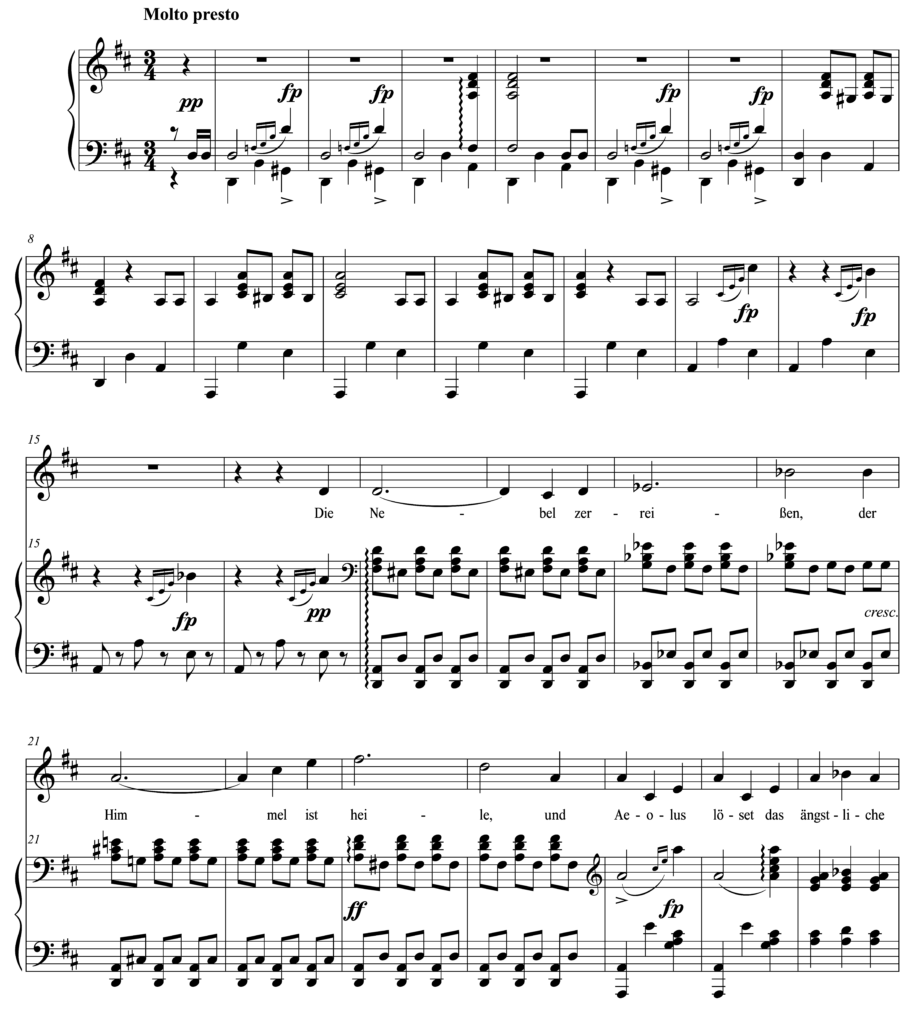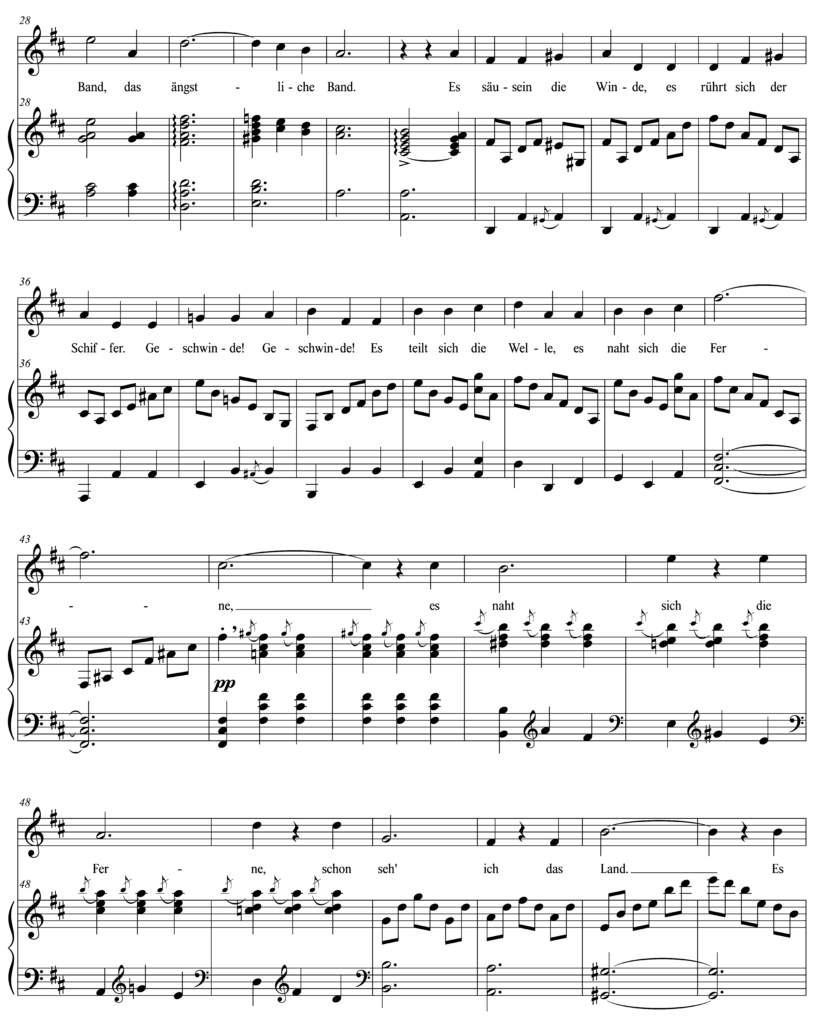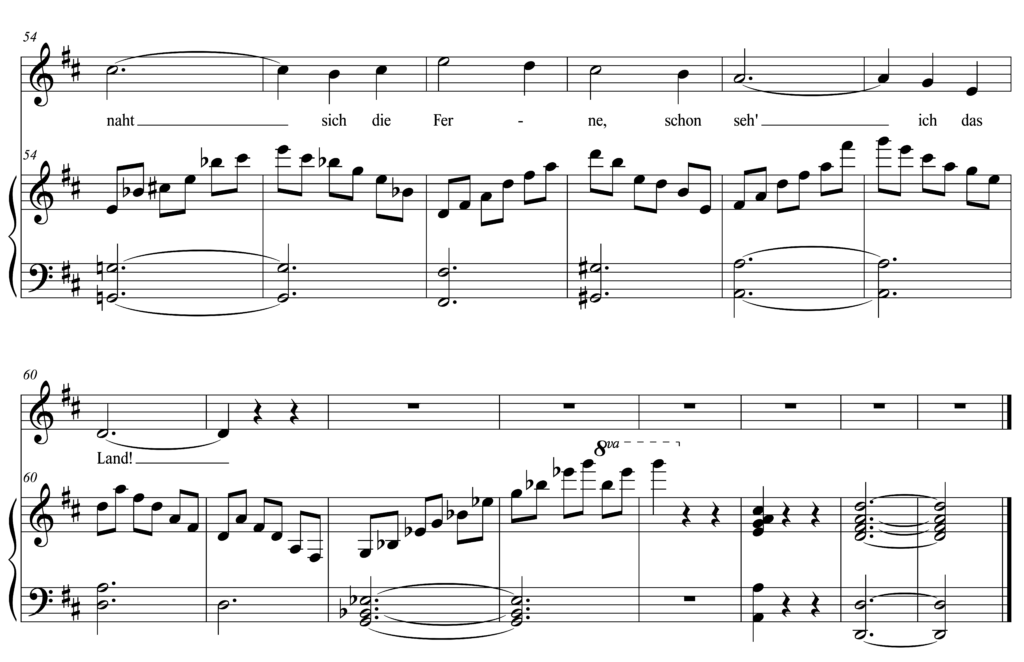Main Body
41 Neapolitan sixth
Learning goals for Chapter 41
In this chapter, we will learn:
- The properties of the (N6) chord
- How to spell the Neapolitan sixth chord
- Best practices for voice leading with the Neapolitan sixth
- How the Neapolitan sixth functions in musical contexts
The chord (N6) is a striking major triad, with the root of lowered scale degree ![]() (“ra”). The latter part of its name—Neapolitan sixth—refers to the figured bass of its most commonly used position, first inversion, with its third (scale degree
(“ra”). The latter part of its name—Neapolitan sixth—refers to the figured bass of its most commonly used position, first inversion, with its third (scale degree ![]() or “fa”) in the bass. According to music theorist William Drabkin, the Neapolitan sixth:
or “fa”) in the bass. According to music theorist William Drabkin, the Neapolitan sixth:
is associated with the so-called “Neapolitan school,” which included Alessandro Scarlatti, Pergolesi, Paisiello, Cimarosa and other important 18th-century composers of Italian opera; but it seems to have been an established if infrequent harmonic practice by the end of the 17th century, being used by Carissimi, Corelli and Purcell.[1]
The N6 has predominant (P) function and therefore usually precedes a dominantly functioning chord, such as the or V. Like other predominantly functioning chords we have studied, the N6 can substitute for any other predominant chord with scale degree ![]() in the bass, such as IV or iv, ii6 or iio6, and ii
in the bass, such as IV or iv, ii6 or iio6, and ii![]() or iiø
or iiø![]() .
.
The N6 is found more often in the minor mode because it has only one altered tone (lowered scale degree ![]() , or “ra”) in minor keys. However, the N6 can appear in the major mode, where it has two altered tones (lowered scale degrees
, or “ra”) in minor keys. However, the N6 can appear in the major mode, where it has two altered tones (lowered scale degrees ![]() and
and ![]() , “ra” and “le” respectively).
, “ra” and “le” respectively).
Study the following examples, and compare the diatonic progression in Example 41‑1 with the one that uses the N6 as a predominant substitute for iio6 in Example 41‑2.
T74 N6 video 1: The basics (5:24)
In this video, we learn about the basic features of the , then study and listen to Examples 41-1 and 41-2.
To see the Neapolitan chord in action, work through Exercise 41-1 or watch video T75, which features the N6 in a beautiful piece by Beethoven.
EXERCISE 41-1 Mini analysis with the N6
Study and listen to the following excerpt. Identify the key and label all Roman numerals and cadences. Circle and label all non-chord tones.
Worksheet example 41‑1. Ludwig van Beethoven, Piano Sonata no. 14, op. 27, no. 2, mvt. 1, mm. 1–5
Listen to a recording of the full movement, performed by Mikhail Pletnev, on Spotify.
Learn about German composer Ludwig van Beethoven (1770–1827) by reading this Oxford Music Online article, written by Joseph Kerman and others.
T75 N6 video 2: Analysis (3:45)
In this video, we examine the opening phrase of the first movement from Beethoven’s Piano Sonata no. 14 (Worksheet example 41-1), which features a prominent N6 chord.
EXERCISE 41-2 Spelling N6 chords
On a separate sheet of staff paper, provide key signatures for each problem and spell each N6.
Access a slideshow with introductory content from this chapter here: N6 slideshow
EXERCISE 41-3 Analysis with N6
Study and listen to Worksheet example 41‑2, which appears below, and complete the following tasks:
- Identify the key: _______
- Provide chord symbols above the staff for mm. 36–40 and mm. 44–50. Describe the type of harmonic process used in these passages.
- Provide a Roman numeral analysis beneath the staff for mm. 52–67.
- What type of chromatic chord occurs in mm. 19–20?
What function does this chord have in the phrase?
What is unusual about the appearance of this chord in mm. 19–20?
This chord recurs near the end of the song. In which measures does this happen? How is the appearance of this chord near the end different from its first appearance in mm. 19–20? - Study the setting and translation of the text, provided in a link beneath the example. In a few sentences, describe the interaction of text and music (such as word painting, connections with texture, harmony, etc.).
Worksheet example 41‑2. Josephine Lang, op. 5, no. 3, “Glückliche Fahrt”
Read an English translation of the song text on lieder.net.
Listen to a recording of this piece, arranged for voice and guitar and performed by Katharina Magiera and Christopher Brandt, on Spotify.
Learn about German composer Josephine Lang (1815–1880) by reading this Oxford Music Online article, written by Marcia Citron.
Voice leading with the N6
When composing chord progressions that use the N6, follow these best practices for smooth voice leading:
- Double the bass (scale degree
 or “fa”).
or “fa”). - The lowered scale degree
 (“ra”) should resolve ultimately to the leading tone. Lowered scale degree
(“ra”) should resolve ultimately to the leading tone. Lowered scale degree  (“ra”) sometimes immediately proceeds to the leading tone, but often it passes stepwise through scale degree
(“ra”) sometimes immediately proceeds to the leading tone, but often it passes stepwise through scale degree  (“do”) to eventually lead to the leading tone. Do not resolve lowered scale degree
(“do”) to eventually lead to the leading tone. Do not resolve lowered scale degree  (“ra”) to diatonic scale degree
(“ra”) to diatonic scale degree  (“re”).
(“re”). - The bass voice should resolve up from scale degree
 (“fa”) to
(“fa”) to  (“sol”). Sometimes another chord, such as viio7/V, may be placed between the N6 and V. In this case, the proper voice leading in the bass would be realized as
(“sol”). Sometimes another chord, such as viio7/V, may be placed between the N6 and V. In this case, the proper voice leading in the bass would be realized as  (“fa”) –
(“fa”) –  (“fi”) –
(“fi”) –  (“sol”).
(“sol”).
Example 41‑3 shows the basic voice leading between outer voices in a simple progression using the Neapolitan sixth. Video T76 walks you through this example.
T76 N6 video 3: Voice leading (3:44)
In this video, we learn how voice leading with the N6 works. Takeaway: “ra” goes to “ti.”
EXERCISE 41-4 Part writing with N6
Given the Roman numerals and starting notes, complete each passage for four voices () following the voice leading guidelines we have studied.
(1)
(2)
(3)
Sight singing with  2
2
Practice singing melodies nos. 32 and 33 from the Melody supplement. Both use scale degree ![]() (“ra”). You can practice no. 32 with video S36 below.
(“ra”). You can practice no. 32 with video S36 below.
S36 Sight singing melody no. 32 (4:37)
This video walks you through singing melody no. 32 (Caldara canon in G minor) from the Melody supplement.
Aural identification of the Neapolitan sixth
Learning to listen for “ra” (![]() ) can be a fun and useful skill to develop. To this end, several exercises below can help you train your ears to hear this striking scale degree and the related chord.
) can be a fun and useful skill to develop. To this end, several exercises below can help you train your ears to hear this striking scale degree and the related chord.
First, it may be helpful to try some melodic dictations to focus on identifying where the “ra” (![]() ) takes place and transcribing it in its rhythmic and metric context. Remember, “ra” (
) takes place and transcribing it in its rhythmic and metric context. Remember, “ra” (![]() ) will always be a half step above tonic, spelled with a different letter name (the letter that comes directly after tonic), and it will require an accidental.
) will always be a half step above tonic, spelled with a different letter name (the letter that comes directly after tonic), and it will require an accidental.
EXERCISE 41-5 Melodic dictation with ![]() 2
2
For each dictation, listen to the melody up to four times. Your goal is to notate the pitch and rhythmic content of each melody on a separate sheet of staff paper. Each of these melodies features lowered scale degree ![]() . Select the right arrow over the image to view the answer.
. Select the right arrow over the image to view the answer.
These dictations also appear as nos. 46–50 in Appendix D.
(1)
(2)
(3)
(4)
EXERCISE 41-6 Contextual listening with the Neapolitan sixth
First, access the playlist here: Spotify playlist for the N6
Choose a track, and play a portion of it. Pause the recording or sing over it, and find tonic (“do”) with your voice or an instrument. Sing or play “ra” (a half step above “do”) and continue listening to see if you can identify where the Neapolitan chord takes place, as it will feature lowered scale degree ![]() (“ra”). If you get stuck, look up the track timing on the answer key and listen again to the excerpt, cued up to the appropriate spot. The playlist also contains some of the pieces we have already studied in this chapter. It may be helpful to review those first before trying new examples.
(“ra”). If you get stuck, look up the track timing on the answer key and listen again to the excerpt, cued up to the appropriate spot. The playlist also contains some of the pieces we have already studied in this chapter. It may be helpful to review those first before trying new examples.
Once you have found the Neapolitan chord, check your answer with the key here: Answers to EXERCISE 41.6 Contextual listening with the Neapolitan sixth
EXERCISE 41-7 Contextual listening with Radiohead, “A Wolf at the Door”
Transcribe as much as possible of the first 16 seconds of Worksheet example 41‑3. Provide the key, time signature, and measure lines. Be sure to notate both the arpeggiated chordal parts as well as the bass, which begins about nine seconds into the clip. After completing the transcription, provide a Roman numeral analysis of the implied harmonies beneath the staff and answer the questions that follow.
Worksheet example 41‑3. Radiohead, “A Wolf at the Door,” 0:00–0:16
Listen to the full track on Spotify.
Learn about English rock band Radiohead by reading this Oxford Music Online article, written by Christopher Doll.
- What type of meter best characterizes this song?
- There is a chromatic chord in this excerpt. In what measures does it occur?
What is the harmonic function of this chord? - Describe the voice leading of the bass line.
What are the implications for this type of bass line in terms of chord voicing?
Supplemental materials for Chapter 41
Brian Jarvis’s chapter on the Neapolitan sixth (Open Music Theory)
Video on the history and early uses of the Neapolitan sixth (Early Music Sources)
Eron F. S.’s video-article “Flat 2 as Hotness in Post-Millennial Pop” (SMT-V 8.5)
- William Drabkin, “Neapolitan sixth chord,” in Grove Music Online. Oxford Music Online, http://www.oxfordmusiconline.com/subscriber/article/grove/music/19658. ↵
striking major triad with predominant function built off the root of lowered scale degree 2 (“ra”), most often found in first inversion
type of second inversion triad that has scale degree 5 in the bass and resolves to a dominant chord, extending dominant function, usually at a cadence
abbreviation for four-voice music, referring to soprano, alto, tenor, bass; may apply to choral music or instrumental music in four parts












